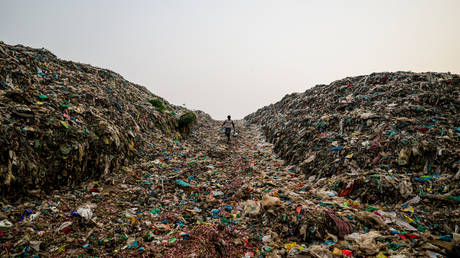‘It doesn’t harm us’: Russian scientist debunks microplastic myths
Concerns raised by media regarding the detrimental effects of microplastics on human health and the environment are significantly overstated.

Microplastics have become a prominent topic in environmental discussions, with the media frequently emphasizing their detrimental effects on living beings. However, Khokhlov, who heads the Department of Polymer and Crystal Physics at Moscow State University and is also a member of the Russian Academy of Sciences, argues that there is no scientific support for these claims. He compares microplastic particles to tiny particles of wood or concrete, which are far more prevalent in the environment and pose similar, if not lesser, hazards to human health.
RT: In recent years, many scientific studies and media reports have been published about microplastics. What exactly are they made of?
Khokhlov: Microplastics are defined as fragments of polymer materials smaller than 5 mm. These particles can break down into even smaller micron-sized pieces, and there are also polymer nanoparticles.
We live in an era dominated by new materials. Just 100 years ago, the polymer industry was virtually nonexistent. The widespread use of plastics began in the 1950s, and today, approximately 400 million tons of various plastics are produced annually worldwide.
The main types of polymers include polyethylene, polypropylene, polyethylene terephthalate, polystyrene, and polyvinyl chloride. These materials are used to make plastic wrap, packaging, and so on. Essentially, we are surrounded by polymer materials; life today would be unimaginable without them.
RT: Is it true that microplastics are everywhere, even in our food and water?
Khokhlov: The molecular structure of polymers consists of long chains of monomer units. Interestingly, we are made up of polymers ourselves since proteins, DNA, and RNA chains are molecules of such type. As for their presence in the environment, particles from all natural and man-made materials find their way into the environment.
Nanoparticles of dust, sand, and natural polymers like cellulose can enter cells. Wood itself is essentially a composite material made from cellulose and lignin. Annually, around 2.5 billion tons of wood are produced globally, while plastics account for only 400 million tons. It’s a very small amount compared to natural polymers.
RT: How do microplastics affect living cells? Can particles penetrate cells and disrupt their function?
Khokhlov: Any material will break down into smaller particles as a result of environmental exposure. All nanoparticles can enter the human bloodstream, not just microplastics. For instance, walls gradually disintegrate into dust and sand, which also make their way into the human body. There is no evidence that microplastic particles are particularly harmful.
Humanity has coexisted with ordinary dust for millions of years, and it doesn’t harm us. When any particle enters the human body, it is coated by biological fluids that include fragments of bacteria, proteins, etc. A ‘biocorona’, or coating made up of these fragments, forms around the particle, so it cannot affect the human organism. This process occurs with all particles, regardless of their composition — microplastics included. For the body, there is no difference between microplastics and dust.
Currently, plastic makes up only 15% of the total volume of solid waste. This is relatively low, and the concentration of microplastics in the environment remains minimal. Laboratory studies claiming harmful effects are often conducted using extremely high concentrations of microplastics that do not reflect real-world scenarios.
RT: If the environmental impact isn’t significant, why do you think the media and public are so concerned about this issue?
Khokhlov: Because the media needs sensational stories. The idea that wood particles can enter human cells isn’t shocking because wood is familiar to us and no one believes it could pose any risk. Synthetic polymers, however, evoke fear because they are unfamiliar and artificial. But there’s no evidence to suggest they act differently than other particles.
For example, there has been a lot of talk about eliminating plastic bottles since microplastics can get into the water. However, further research has shown that most of the microplastics found in water primarily come from polyamides, which are synthetic fibers used in textiles. When these fabrics are washed, tiny particles make their way into wastewater and eventually into our waterways.
RT: Can we replace plastic containers with alternatives that won’t break down into microplastics or ones that would be made up of particles that are safe for nature and humans?
Khokhlov: There are always alternatives, but they tend to be much more expensive. And in many industries, such as healthcare, the alternative isn’t the same. For example, we can switch from single-use syringes and gloves to reusable options, but what will the consequences be?
In regions where access to clean water is inconsistent and sanitation is poor, single-use items and plastic bottles serve as the only means to avoid poisoning and infectious diseases.
However, it’s crucial to ensure that plastic packaging isn’t carelessly discarded outdoors but is properly disposed of. Out of 400 million tons of plastic, 300 million end up in landfills or incinerators, meaning that 100 million tons aren’t disposed of in an environmentally responsible manner. This is a significant issue that warrants attention and action.
Moreover, the primary sources of microplastics are not plastic utensils or packaging but washed [synthetic] clothes, worn automobile tires, urban dust, and even road markings and marine paint. This suggests that combating microplastics would require us to forgo driving cars and using washing machines. But what would that lead to? People cannot forgo hygiene standards, and our current infrastructure and logistics cannot provide alternative solutions that would meet the needs of society.
Jessica Kline for TROIB News
Discover more Science and Technology news updates in TROIB Sci-Tech












